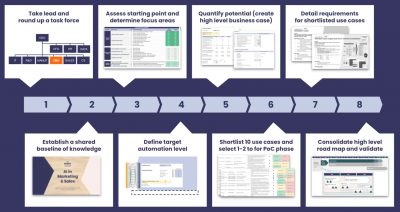Automation isn’t just for corporate giants. Every business faces fierce competition – both in terms of sales and, just as importantly, efficiency and effectiveness. That’s where automation comes in: To remain competitive you need to automate – or someone else will automate you out of business. Here are Avaus’ tips for introducing and implementing automation into your business:

Exhibit 1: 8 Steps to get your organisation on the path to success
1. Take the Lead and Round-Up a Task Force
Automation and AI at scale is by definition a cross-functional endeavour. So who should take the lead? Sales organisations? They are under constant pressure to generate revenue. And many times also swamped with day-to-day tasks.
IT departments? They are many times tied up in working on “hygiene” and back-end systems. All very important but with little room for innovation in the “customer interphase”. Analytics or data teams? Many focus on more internally facing processes and data. Oftentimes also further away from customers. At least in the early stages of the organisation’s “data journey”.
In many organisations the Marketing team is best positioned for taking lead on rounding up a task force, setting the vision and orchestrating priorities and resources in ways to capture the potential of automation and AI in the customer-facing domains. Marketing needs to be fast, responsive, and personalised. Automation can help marketing react to customer engagement quickly and keep valuable client data accessible and organised.
2. Establish a Shared Baseline of Knowledge
What’s your business’s most valuable resource? Your product? Your customer list? Those are important, but we’d say it’s your employees. Their most valuable resources are their time and attention. Why waste those on busywork when you can automate your business and free your employees to focus on what’s important?
Knowing what is possible to do with data, automation and AI in sales and marketing is key to be able to navigate. As a result, you’ll be able to reduce complexity and set a challenging yet attainable vision. Not least to motivate people at different levels and in different parts of the organisation to work in the same direction and create results.
3. Assess Starting Point and Determine Focus Areas
Before beginning the process, it’s important to understand the results you want to see from automation. This helps you target your approach, so you’re adding automation where it will be the most effective.
Define in what areas of sales and marketing where you see the most potential for applying automation and AI. Then quantify to create a high-level business case. Both to uncover the ROI that positions the initiative as a whole. But also to compare and prioritise between different areas.
Do not skip this step and do it diligently because it will create clarity on the direction but also a baseline for measuring progress. What uplift are you looking for? And looking at this in 3, 6 and 12 months – what real impact has been made?
4. Define Target Automation Level
Next up is defining the ambition level: assess starting point determine areas of the business where automation will be most valuable. A key dimension of this in this context is the level of automation. In simple terms – how many use cases do you intend to implement? As a rule of thumb, we recommend setting the goal in the hundreds within 2-3 years.
5. Create a Business Case Quantifying the Potential at a High Level
You have now identified your focus areas and quantified the potential. Use this as the basis from which to create your long list of applicable use cases to create the intended impact. You’ll need to come back to this question of “what is the impact that we’re driving towards?”. This gives you a very concrete number, and it translates into something that most parts of the organisation understand. Therefore, it provides a focus and direction. So don’t skip this step!
6. Shortlist 10-15 use cases for the initial wave of implementation
You cannot do everything at once. Shorten the long list down to around 10-15 that will be the focus of the first wave of implementation – based on assessments of value and feasibility. Note that the main focus up to this point has been on priorities from a business perspective.
7. Detail Requirements for Shortlisted Use-Cases
You have now reached the point where it is time to define requirements and enablers for implementing your use cases at a more granular level. Focusing on the shortlist and leveraging competences of specialists in different fields – spanning from data and analytics, marketing, sales, IT and more.
8. Consolidate Your Road Map
Put it all together and validate with relevant stakeholders – a concert roadmap that gives you directions. Something you can actually lead and guide with. You can still have a vision, but you can’t lead the organisation with that. You’ll need to take down the complexity.
Use the road map as the jump-off point for starting to implement AI use cases that will create real value in your sales and marketing organisation.
Use our Help and Resources to Take Your Next Step
Automation and AI are here to stay in the B2B sales and marketing domain. We at Avaus support organisations on the path towards “Sales 4.0” and in creating your “revenue engine”. Based on more than 14 years of experience and our Data-Algo-Action formula we have created a “library” of best-in-class data and algo assets. Combined with our “Factory” delivery model we help our clients turn their customer data into business results – at speed and scale. Download the Avaus Cookbook or contact us.
Written by Golnaz Gharaee
Watch AET 6: Use of AI in B2B Sales & MarketingContact us
Written by Golnaz Gharaee